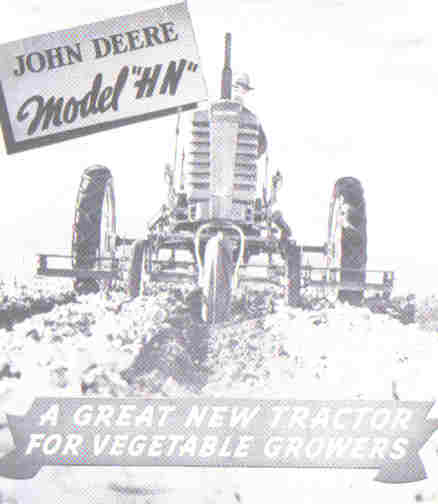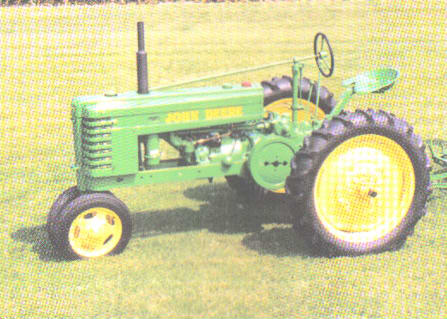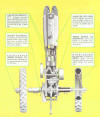John Deere H
Tractors - perfect size
for small Farms
|
|
Manufactured from 1939 to 1947 the John Deere Model H
The John Deere Model H was a small tractor that met a small farmer's
needs for power at a price he could afford. Larger farms liked the H
for it's ability to do lightweight jobs economically.
The Model H was included in the green tractor lineup as a "filler"
between the smaller L and the larger Model B tractors.

Model H
Model HN (narrow...single front wheel)
Model HWH (wide front end, high rear end)
Model HNH (single front wheel, high rear end)
The H designation on the end stands for high clearance. The higher rear
axle clearance was accomplished by using a 38 inch Model B wheel
with a special hub to fit the H axle. Regular rear wheels on the
H were 32 inches in diameter.
On Model H's the air intake hole is located on the left (flywheel)
side of the hood just forward from the John Deere decal, it is
covered with wire screening.
John Deere Model H Tractor

The clutch and belt pulley are driven off the camshaft instead of the
traditional crankshaft. The belt pulley thus operated counterclockwise.
Operating off the camshaft allowed higher engine speed of 1400 rpm.
An over pulley was available to increase belt speed from 2245 feet per
minute to 3000, used to operate the 10 inch John Deere 10-A Hammermill.
The Model H had a foot operated governor override which allowed faster
road travel.
In 1940 a power lift was made for the tractor.
Steel wheels were not an option, the Model H as only available with
rubber tires.
Click on picture to see full page view model H advertisement.

The engine in the Model H was the smallest two cylinder horizontal
engine ever put on a John Deere tractor.
The prototype tractors for the H were known as OX models. The OX
designation was also used for a variety of later models of JD tractors.
The OX, soon to be Model H's were built unstyled. When the decision was
made to style the A & B, the OX models became styled. The exact
tractors that were tested were OX138 thru OX143. These were either
scrapped or rebuilt as H's.
There were no bull gears in the Model H. Thus the brakes were directly
applied to the axle shafts.
The high crop models, HNH were only built in 1941 and January of 1942
and all shipped to California. They are known as California High Crop H's.
There were 37 HNH's built.
Only about a thousand Model HN tractors were built. 125 HWH's were built.
In 8 years of production some 60,000 H's and varieties were produced.
A new 1939 Model H cost $595.
The original Model H was rated at 9.77 drawbar and 12.97 belt horsepower.
It weighed 2054 pounds.
Cost to produce the first Model H tractor was approximately:
$122,000 for design
$312,000 for tools
$166,000 for buildings
$407,000 for machinery
A total of $1,007,000 plus wages, testing, advertisement, equipment to
go with it.
Only 126 HWH tractors were ever made.
1946 was a significant year in the farm implement business. The John Deere
116W automatic wire tying pickup baler was introduced. It was the world's
first baler that featured automatic wire tying of the bales. Wire tying was
always the job of two men riding the baler, who could now be free to
pick up the bales. The wire tie balers were offered in two models, the
116W and for smaller bales the 114W.
In 1955 the famous 14 T twine tying baler was introduced. In 1957 another
Deere first came, the automatic bale ejector.
Next Page: Model Y
Back to Model G
History of John Deere Tractors
|